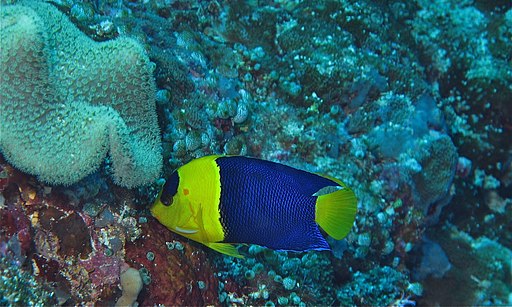Bicolor Angelfish Guide
Thinking about adding the Bicolor Angelfish to your mixed reef tank? You may want to think again. I had seen a beautiful specimen in a local fish store recently and set out to understand the husbandry needs to determine if it is a good addition to the tank. If you are thinking about keeping this species in your saltwater aquarium, check out this post first.
Introduction
The Bicolor Angelfish, Centropyge bicolor, is an easily recognizable species of dwarf angelfish originating in the Indo – Pacific area, in reefs around New Calcedonia, Fiji, Papua New Guinea, Micronesia, etc. It is also alternatively called Blue and Gold Angel, Oriole Angelfish, Two-colored Angelfish because (you guessed it) of the blue and yellow coloration.
Its lifespan in the wild is known to be about 5 – 10 years, but it can live up to 12 years in captivity in adequate water conditions. Some specimens have even survived to be 15 years old. The Bicolor Angelfish would reach up to 6 inches long.

Ideal habitat
Like other dwarf angelfish, you can expect the Bicolor Angelfish to be always in constant motion, picking at live rock and the aquarium glass hoping for a tiny morsel of food. As such, this fish is best kept in larger tanks (70 gallons or larger) with plenty of live rock, both for structure and for foraging.
You want to maintain high-quality water within the standard range of acceptable reef aquarium parameters. For more specific information about this, check out this page.
Feeding
The Bicolor Angelfish needs a diet balanced with meaty foods (mysid shrimp, brine shrimp, blackworms, etc.) as well as with algae (Spirulina flakes, nori sheets, etc.)
Feed your Bicolor Angelfish about 2 to 3 times a day is generally a good practice. Especially if you want to keep the fish from nipping at sessile invertebrates.
Behavior and tank mates
Buyer beware, there is a cost to add this beautiful fish to your tank because the Bicolor Angelfish is a notorious polyp and clam mantel nipper. It will sample the smorgasbord of invertebrate delicacies available in your tank–so it is best kept in a fish only tank–or in a tank where you won’t mind the occasional grazing of your prized corals.
The Bicolor angelfish are aggressive towards their own species and other dwarf angelfish, so if you want to keep this angelfish, it will be your only angelfish.
Angelfish also have a reputation to be a bit aggressive–so if you are adding this fish to your tank, it is probably best to add it as one of the last fish to the tank, so that all the others have a chance to establish a territory prior to its introduction.
Otherwise, the Bicolor Angelfish should reasonably live amongst the other fish in your tank.

Pros and cons
In summary, here are a few of the pros and cons of keeping the Bicolor Angelfish in your saltwater aquarium.
Pros
- Active swimmers
- Big appetites
- Long-lived
Cons
- NOT Reef safe
- A tad aggressive
- Need a large tank (70+ gallons) with ample live rock to be happy
Conclusions
I don’t mean to dissuade you from picking up this delightful fish, but I can tell you that I plan to pass on it. I don’t want to take the risk that it will harass my corals. 15 years is a long time to live with a coral nipper.
How about you, would you take the chance? Have you already taken the chance?

Leave a Reply